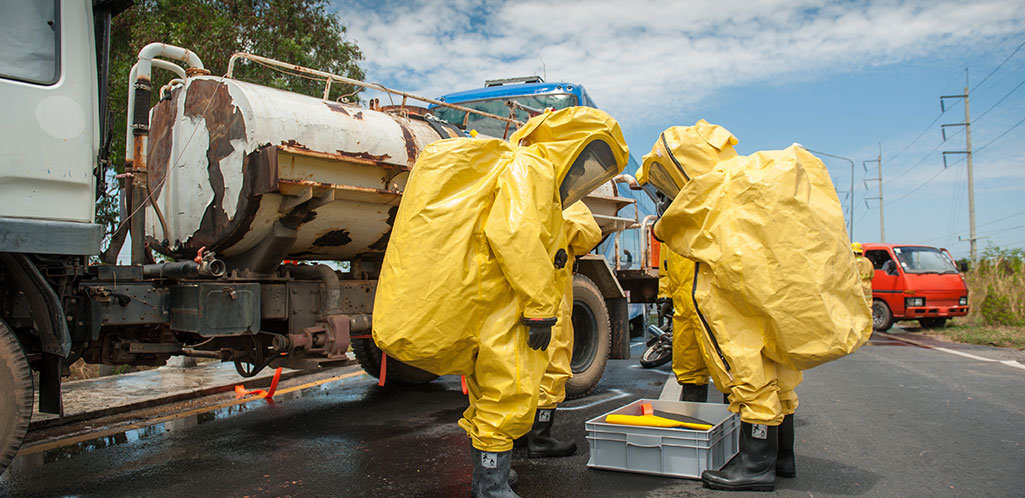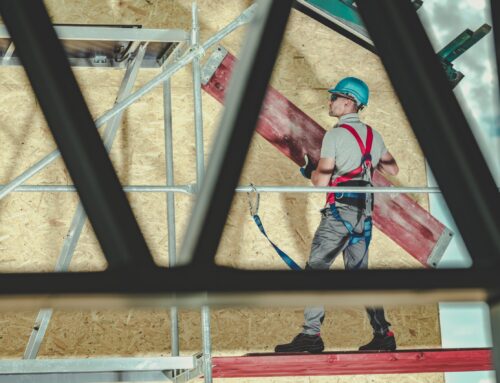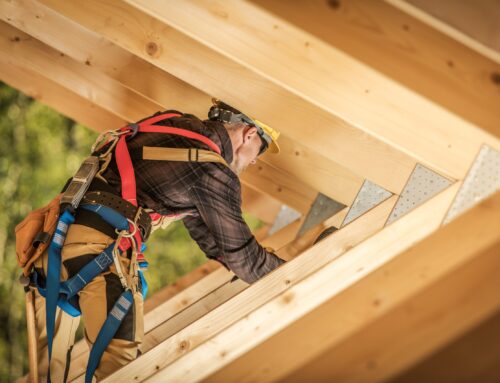Employees who are engaged in emergency spill response operations no matter where they occur are covered by the Occupational Safety and Health Administration’s (OSHA’s) Hazardous Waste Operations and Emergency Response (HAZWOPER) standard, 29 Code of Federal Regulations (CFR) 1910.120. As first steps in limiting worker exposure to spill hazards, engineering controls and administrative (work practice) controls must first be considered. If circumstances prohibit the use of engineering controls or work practices, or these measures do not sufficiently reduce worker exposures, OSHA mandates that personal protective equipment (PPE) be used.
Once the need for PPE is established, a careful evaluation of the hazards is necessary so selections can be made to minimize the risk to the user. For chemical situations, this includes knowing the chemical(s) involved, level of exposure (or potential exposure), physical state (liquid, solid or gas), and physiological effect(s) (toxic, carcinogen, asphyxiate, corrosive, etc.). However, when responding to a spill, much of this information is not known. In situations like this, the highest level of protection is needed.
Levels of Protection
To help users choose a total PPE package for spill cleanup, the Environmental Protection Agency (EPA) Office of Emergency and Remedial Response determined four levels of chemical risks. These levels range from unknown or highly hazardous, which requires complete protection, to non-hazardous, which requires basic work attire only. Appendix B (non-mandatory) to 29 CFR 1910.120 provides guidelines that employers can use to begin the selection of appropriate PPE. Although the Appendices to 29 CFR 1910.120 are non-mandatory, paragraph 1910.120(g)(3)(i) states “Personal protective equipment (PPE) shall be selected and used which will protect employees from the hazards and potential hazards they are likely to encounter as identified during the site characterization and analysis.”
Level A protection is required when the greatest potential for exposure exists and when the highest level of skin, respiratory and eye protection is required.
Required:
- Positive pressure, full face-piece self-contained breathing apparatus (SCBA), or positive pressure supplied air respirator with escape SCBA, approved by the National Institute for Occupational Safety and Health (NIOSH).
- Totally-encapsulating chemical-protective suit.
- Gloves, inner and outer, chemical-resistant.
- Boots, chemical-resistant, steel toe and shank.
Optional (as applicable):
- Long underwear.
- Hard hat (under suit).
- Disposable protective suit, gloves and boots (depending on suit construction, may be worn over totally-encapsulating suit).
Level B protection is designed to offer the highest level of respiratory protection, but a lesser level of skin protection.
Required:
- Positive pressure, full face-piece self-contained breathing apparatus (SCBA), or positive pressure supplied air respirator with escape SCBA, approved by NIOSH.
- Hooded chemical-resistant clothing (overalls and long-sleeved jacket; coveralls; one or two-piece chemical-splash suit; disposable chemical-resistant overalls).
- Gloves, inner and outer, chemical-resistant.
- Boots, outer, chemical-resistant, steel toe and shank.
Optional (as applicable):
- Boot-covers, outer, chemical-resistant (disposable).
- Hard hat.
- Face shield.
Level C features the same type of clothing as level B, but has a lower level of respiratory protection. An air-purifying respirator is used in place of a self-contained breathing apparatus (SCBA). This level is used when the chemical(s) and the airborne concentration(s) are known and it has been established that an air-purifying respirator is appropriate protection for the hazard. The following constitute Level C equipment:
Required:
- Full-face or half-mask, air purifying respirators (NIOSH approved).
- Hooded chemical-resistant clothing (overalls; two-piece chemical-splash suit; disposable chemical-resistant overalls).
- Gloves, inner and outer, chemical-resistant.
Optional (as applicable):
- Boots (outer), chemical-resistant steel toe and shank.
- Boot-covers, outer, chemical-resistant (disposable).
- Hard hat.
- Escape mask.
- Face shield.
Level D offers the lowest level of protection and is used when no potential or actual hazard exists. It offers minimal protection for nuisance exposure—generally a work uniform. The following constitute Level D equipment:
Required:
- Boots/shoes, chemical-resistant steel toe and shank.
Optional:
- Boot-covers, outer, chemical-resistant (disposable).
- Safety glasses or chemical splash goggles.
- Hard hat.
- Escape mask.
- Face shield.
Suit Material Selection
After the appropriate level of PPE for spill cleanup has been determined, the choice of chemical protective clothing (CPC) material must be considered. The more important factors in selecting the appropriate CPC are chemical resistance and suit design.
The effectiveness of the CPC to resist chemicals is generally measured by permeation testing. Permeation is the process by which a chemical moves through a sample of protective clothing material at a molecular level. Permeation testing tells us two things: breakthrough time and permeation rate. Permeation tests are conducted by following ASTM F739 Test Method for Permeation by Liquids and Gases. Breakthrough time is the time it takes the test chemical to pass from the outside surface of the sample to the inside surface of the sample. Permeation rate is the speed at which the test chemical passes through the sample once breakthrough has occurred. The ASTM F739 method only tests a swatch of the actual CPC fabric. This means that the potential for permeation through a zipper, seam, etc. is not determined. Chemical resistance data is available from many manufacturers and distributors. Unpublished data may be supplied by manufacturers upon request.
Suit design deals with how a garment is put together. Seams are an important aspect of suit design. Two pieces of material can be joined by either stitching or welding. The stitching process can create pin holes that may allow penetration of chemicals. Welded seams involve cementing or welding tape over the stitched seam. The welded seam offers a higher level of protection against exposure to contaminants.
Choosing a Glove Material
As with CPC, chemical resistance and the physical characteristic of a glove material are important. Different glove materials resist different chemicals, so no one glove is suited for all chemical exposures. A glove that is well-suited for one application may prove dangerous for another. Glove material selection must be based on the glove manufacturer’s chemical resistance guide. The actual chemical compatibility of a given glove material can vary from manufacturer to manufacturer. Another factor to consider is chemical combinations. Glove permeation guides generally list test data for pure chemicals only, not mixtures. In the non-mandatory Appendix B to the PPE standard 29 CFR 1910 subpart I, OSHA recommends the following for chemical mixtures:
“11(c) For mixtures and formulated products, (unless specific test data are available), a glove should be selected on the basis of the chemical component with the shortest breakthrough time, since it is possible for solvents to carry active ingredients through polymeric materials. For further information on chemical combinations, check the Safety Data Sheet provided by the manufacturer.”
Choosing Protective Eye and Face Protection
Eye and face protective equipment is available in several styles, sizes and materials. It is very important to match the proper protection to your work application. OSHA’s regulation 29 CFR 1910.133 requires the use of eye and face protection when workers are exposed to eye or face hazards such as flying objects, molten metal, liquid chemicals, acids or caustic liquids, chemical gases or vapors, or potentially injurious light radiation. OSHA’s regulation 29 CFR 1910.132(c) requires all PPE to be of safe design and construction for the work to be performed. To satisfy this requirement, the majority of eye and face protection in use today is designed, tested and manufactured in accordance with the American National Standard for Occupational and Educational Personal Eye and Face Protection Devices ANSI Z87.1-2010 or 2015 standard.
Goggles offer the most complete protection because they form a seal around the eye area preventing tiny dust particles, chemical splashes and vapors from irritating the eyes. There are two types of goggles: vented and non-vented (vented can be either indirect or direct). Non-vented goggles are just that, lenses and frames with no holes for air to seep through. They offer a higher level of protection against vapors and fumes, and can be used to keep harmful vapors out of sensitive eyes. Indirect-vented goggles are capped to allow air to move freely in and out without allowing splash or particles in. They offer the same impact protection as the direct-vented goggles. Lens fogging can be a problem. You may want to consider an anti-fog lens coating to alleviate any potential problems. Direct-vented goggles offer protection from impact only. They fit snugly around the eye area to prevent flying objects from striking your eyes. They also offer more comfort because they allow air to flow in and out to reduce the chance of fogging.
ANSI Z87.1-2015 defines a face shield as “a protector intended to shield the wearer’s face, or portions thereof from certain hazards, as indicated by the face shield’s markings.” A protector is a complete device—a product with all of its components in their configuration of intended use. Although it would seem that face shields meeting the performance criteria of the 2015 standard can be used as standalone devices, all references in the modified Eye and Face Protection Selection Tool refer to “face shields worn over goggles or spectacles.”
Chemical resistant face shield visors are constructed from several types of materials. These materials include polycarbonate, propionate, acetate, and polyethylene terephthalate glycol (PETG). It is important to select the proper visor for the work environment.
Polycarbonate material provides the best impact and heat resistance of all visor materials. Polycarbonate also provides chemical splash protection and holds up well in extremely cold temperatures. Polycarbonate is generally more expensive than other visor materials.
Acetate provides the best clarity of all the visor materials and tends to be more scratch resistant. It also offers chemical splash protection and may be rated for impact protection.
Propionate material provides better impact protection than acetate while also offering chemical splash protection. Propionate material tends to be a lower price point than both acetate and polycarbonate.
Polyethylene terephthalate glycol (PETG) offers chemical splash protection and may provide impact protection. PETG tends to be the most economical option for face shield choices.
Sources
29 CFR 1910 Subpart I Personal Protective Equipment
29 CFR 1910.120 Hazardous Waste Operations and Emergency Response
29 CFR 1910.133 Eye and Face Protection
The information contained in this article is intended for general information purposes only and is based on information available as of the initial date of publication. No representation is made that the information or references are complete or remain current. This article is not a substitute for review of current applicable government regulations, industry standards, or other standards specific to your business and/or activities and should not be construed as legal advice or opinion. Readers with specific questions should refer to the applicable standards or consult with an attorney.
Source: Grainger Know How – https://www.grainger.com/know-how






